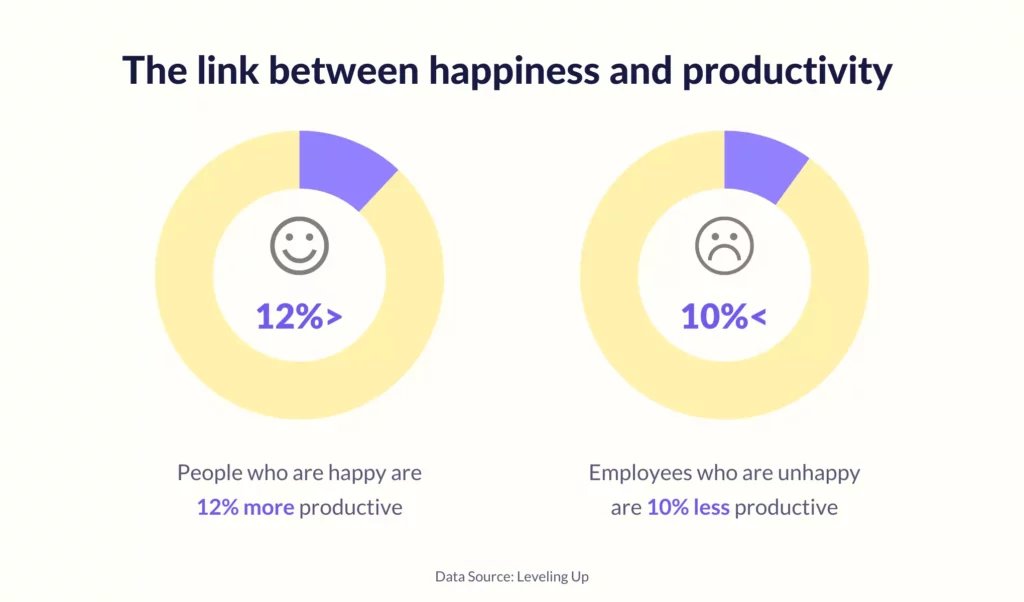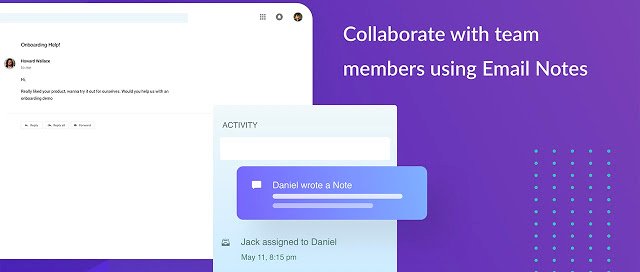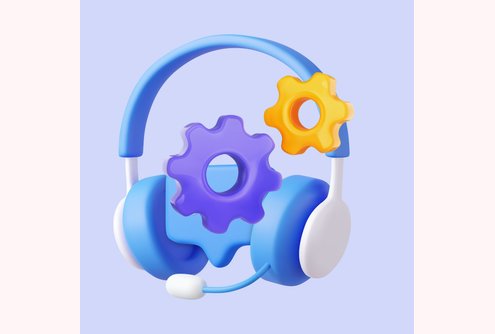Happy employees are productive employees. It’s not a supposition—it’s a fact backed by a full-fledged study: the 700-person experiment.
For the study, researchers chose employees at random and either showed them a 10-minute comedy clip or gave them snacks/drinks. Then, they checked with a series of questions to gauge if they were actually happy—they were.
Finally, they were given a task to measure their productivity—it was 12% higher than another control group which was not under the happiness shock. Happy employees are certainly more productive.

Table of Contents
- What is an internal helpdesk?
- Why do you need an internal helpdesk?
- The internal helpdesk keeps brewing happiness
- How to manage an internal helpdesk effectively
- What do employees want from internal support?
- What does your team need to work faster and better?
- Try Hiver
What is an internal helpdesk?
An internal helpdesk is a centralized hub within an organization that provides technical support to employees. It’s the go-to place for resolving IT issues, answering tech-related questions, and assisting with software and hardware problems. Unlike external help desks that serve customers, an internal helpdesk focuses solely on keeping the company’s own operations up and running.
It’s where employees go—digitally, of course—when they’re having tech issues or need help with internal software and hardware. Think of it as the “tech troubleshooters” within your organization. They handle everything from “Why won’t my computer start?” to “How do I access the VPN?”
Why do you need an internal helpdesk?
Ever calculated the cost of downtime when an employee’s computer crashes or a software glitch halts a project? The numbers can be staggering. An internal helpdesk isn’t just a support center; it’s a financial safeguard and a productivity engine for your business. By centralizing tech support, you’re not just fixing problems — you’re investing in a smoother, more efficient operation that directly impacts your bottom line.
Streamlined Communication
Ever tried to solve a tech issue by playing email ping-pong with your IT team? It’s a mess. An internal helpdesk centralizes all those requests.
Use Case: When Jane from accounting can’t access her financial software, she logs a ticket. The IT team sees it, prioritizes it, and gets it sorted. No more lost emails or communication breakdowns.
Faster Problem Resolution
Intro: Time is money, especially when tech issues bring work to a standstill. A helpdesk speeds up the troubleshooting process.
Use Case: Mark’s computer crashes in the middle of a project. Instead of waiting in a queue of emails, his ticket gets immediate attention based on its urgency, and he’s back up and running quickly.
Knowledge Base
Why solve the same problem multiple times? A helpdesk often comes with a knowledge base where common issues and solutions are documented.
Use Case: Sarah can’t figure out how to set up her dual monitors. She checks the knowledge base and finds a step-by-step guide, saving both her time and the IT team’s resources.
Accountability and Tracking
Who’s doing what? When was it done? An internal helpdesk keeps a record of all actions taken, making it easier to track performance and issues.
Use Case: The CTO (Chief Technology Officer) wants a monthly report on the types of issues faced and how quickly they were resolved. The helpdesk provides all this data in an easily digestible format.
Onboarding and Training
New hires often have a ton of questions and need various software and permissions set up. A helpdesk streamlines this process.
Use Case: Emily is new and needs access to several internal systems. She submits a ticket, and the IT team sets her up with everything she needs, all tracked and documented.
Streamlining the process of issue reporting and resolution allows employees to focus on what they do best, whether that’s coding, selling, designing, or strategizing.
The internal helpdesk keeps brewing happiness
Things break. The internet goes down. Laptop chargers go bad. And it comes in the way of work—people get frustrated. An internet outage or a browser that keeps crashing can make the calmest of employees (aka your end-users in this case) lose their minds.
When things break, there’s always a bigger impact (much beyond displeasing employees):
Email attachments getting blocked? You might have lost out on a major deal.
CRM down? Prepare your IT team to deal with a horde of angry customers.
QA server acting up? You might miss your release deadline.
Your customer support teams, developers, marketing folks, sales wizards—everyone needs smoothly functioning systems in place.
And this is where a powerful internal helpdesk is going to make a difference.
When you solve employees’ problems quickly, you’re making their lives easier.
And how do you keep doing that every day? You need a helpdesk solution that manages your internal operations smoothly— that helps you assign emails to your team quickly— that helps your team work together to solve employees’ problems.
No matter what you do, whether you’re an engineering company or an online retailer, or even a fledgling social network, a responsive internal helpdesk can aid not just efficiency, but morale (or in customer service terms – customer satisfaction) as well.

How to manage an internal helpdesk effectively
Managing a helpdesk effectively is a bit like conducting an orchestra. You’ve got different sections, each with its own role, and they all need to work in harmony to create something impactful. Here’s how to make sure your helpdesk hits all the right notes:
Prioritize Tickets
Not all tickets are created equal. Some are urgent, while others can wait. Effective prioritization ensures that critical issues get immediate attention.
Imagine a scenario where the company’s email server goes down. This is a high-priority ticket that affects everyone in the organization, from the CEO to the interns. Prioritizing this ticket ensures it gets resolved ASAP, minimizing downtime and business impact.
Train Your Team
A well-trained team is the backbone of an effective helpdesk. They need to know more than just the technical stuff; they need excellent communication skills too.
Let’s say a team member encounters a new software bug that’s causing data loss. Because they’ve been trained in problem-solving and communication, they fix the issue and create a guide for other team members, streamlining future resolutions.
Use Automation Wisely
Automation can be a game-changer, but only if used correctly. It can handle repetitive tasks, freeing up your team for more complex issues.
Automate routine tasks like ticket sorting, initial responses, or even solving common issues through a self-service portal. But always have a human fallback for more complicated or sensitive matters.
Keep Communication Open
A helpdesk is a two-way street. Open communication channels between your team and the end-users can lead to quicker resolutions and better relationships.
Use chat systems, regular updates, and feedback loops to keep everyone in the loop. Transparency can significantly improve the user experience.
By prioritizing tickets, training your team, using automation wisely, monitoring performance, and fostering open communication, you’re not just solving immediate issues—you’re building a resilient support infrastructure. This infrastructure can adapt to challenges, learn from them, and continuously improve, making your helpdesk not just a problem-solving unit but a strategic asset for your organization. And that, my friend, is the real value of effective helpdesk management.
Monitor and Analyze
What gets measured gets managed. Regular monitoring and analytics can provide insights into helpdesk performance and areas for improvement.
Use dashboards and reporting tools to track metrics like response time, resolution time, and customer satisfaction. Use this data to make informed decisions.
Get real-time actionable insights
What do employees want from internal support?
Employees rely on your IT department way more than you think. They wait for you to solve their problems so that they can get back to work.
Here’s what functionality most people expect from internal helpdesks:
1. Easy to reach
No logging into websites with a confusing layout and buggy text input fields to log support tickets. Just an email. It’s on their phone. It’s on their laptop. Send an email with your support request—forget about it—go grab a coffee.
2. Zero fuss
Nobody likes to be dragged into conversations they don’t need. Employees do not want to be Cc’d on emails your support staff exchange to discuss the issue. Let your team deal with the problem—and let the employee get back to work.
3. Time-bound resolution
Your employees will love it when their problems are solved within a reasonable time frame. You’d need a system that helps you frame SLAs (Service Level Agreements) and keeps your IT support team on top of emails, and helps them resolve issues quickly.
4. Status updates
Your employees will appreciate being kept in the loop about the status of their issue. Sending timely alerts in case of escalations would set the right expectations for them.
What does your team need to work faster and better?
You’d want your IT service team to have clarity about what they have to work on, and the ability to take help from others on the team without much hassle.
1. Automation to reduce manual involvement
It would be great to have a helpdesk ticketing system that can automate email assignments for your team based on pre-set rules. You’ll be able to create routing workflows that evenly distribute emails to your team, and you will never run the risk of missing an email.

2. Confusion-free internal discussions
Some tricky issues may need your teammates to work together. Why subject everyone to a long email thread by keeping them in Cc? Take internal discussions away from email and you’ll avoid confusion.

3. Analytics and insights
You’d love a tool that lets you assess your team’s performance metrics in real-time. Analytics and insights can be a boon to ensure your team is solving problems efficiently and within the resolution time. At the same time, you’ll be able to pinpoint areas of improvement for individual team members.

4. Low-maintenance
Your internal helpdesk software should be the last thing your IT team needs to worry about. Something that’s easy to deploy, dovetails perfectly with your existing email system, and works invisibly in the background—will make your life simple.
Try Hiver
Hiver has got everything you need for the smooth functioning of your internal operations. It’s proven to be a fantastic tool for helpdesks, service desks, and ticketing systems, as many customers have found.
If you want to see how Hiver can work for your team, you can always schedule a demo with us. Alternatively, you can try Hiver now, free for 14 days.


































